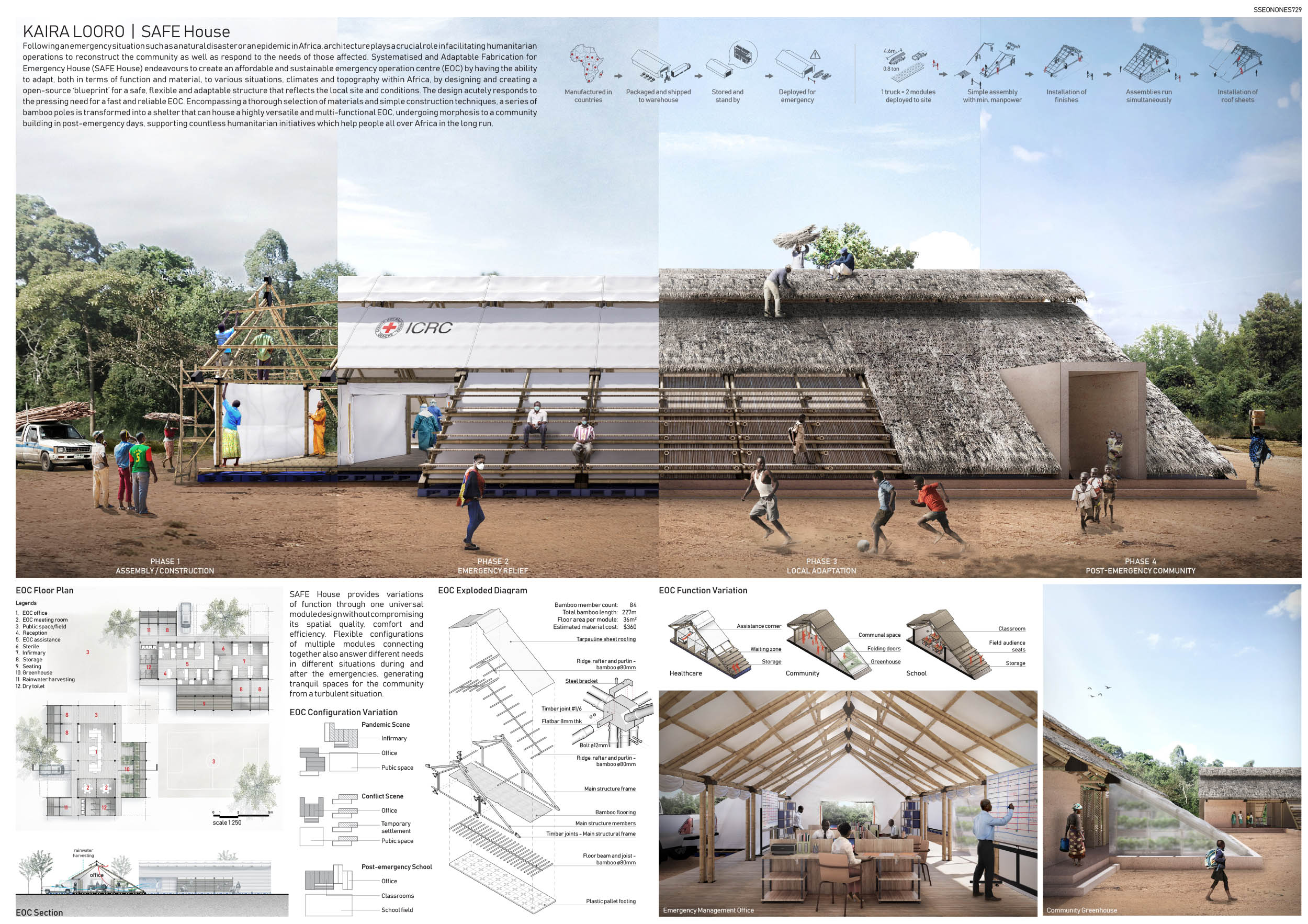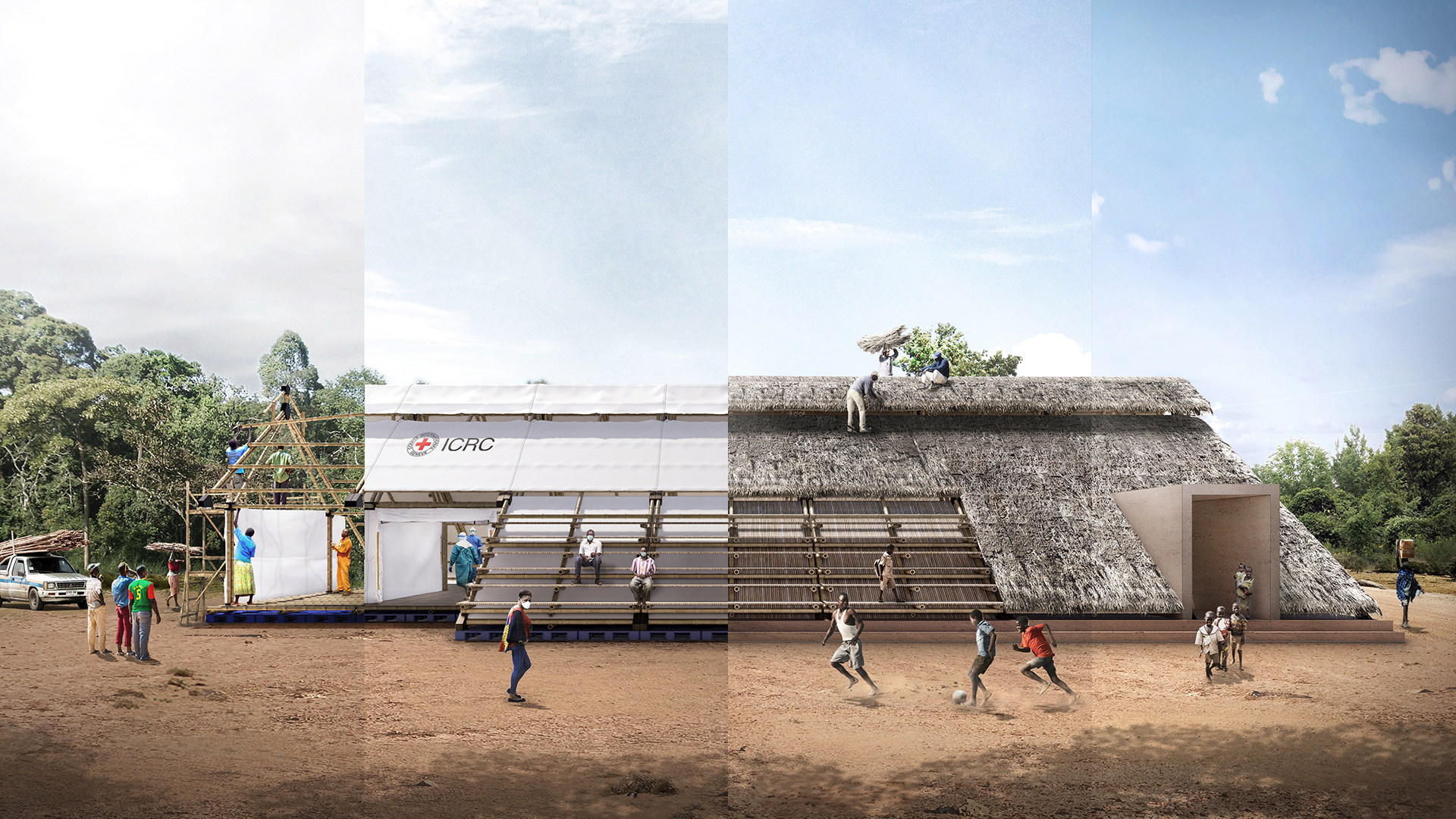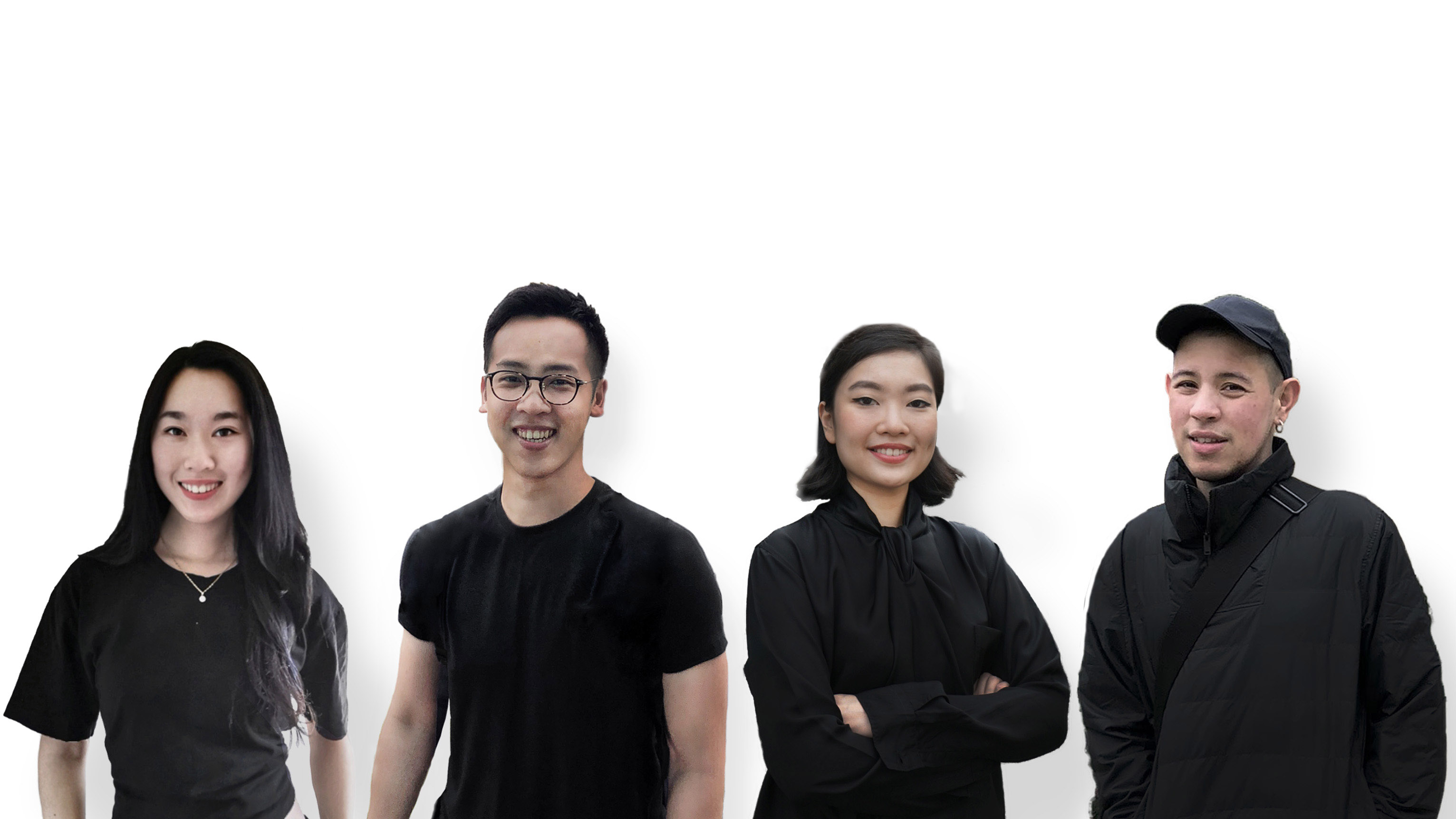2nd Prize
1st Prize - 2nd Prize - 3rd Prize - Honourable Mentions - Special Mentions - FinalistSSEONONES729
Project by: Clarisse Gono, Tsunxian Lee, Nathan Mehl, Katherine Huang.from Philippines


SAFE House: Systematised and Adaptable Fabrication for Emergency House
Design Idea
Following an emergency situation such as a natural disaster or an epidemic i n Africa, architecture plays a crucial role i n facilitating humanitarian operations to reconstruct the community as well as respond to the needs of those affected.Therefore our aspiration for this project i s to create an affordable and sustainable architectural solution for an Emergency Operation Centre (EOC). Systematised and Adaptable Fabrication for Emergency House (SAFE House) endeavours to address these solutions by having the ability to adapt, both i n terms of function and material, to various situations, climates and topography within Africa. We cannot foresee every calamity but we certainly can always be prepared. Emergencies can strike without warning and i n a matter of a split second people’s lives can be at deep risk. Hence, solutions need to be provided beforehand i n preparation for such emergencies. By designing and creating a ‘ blueprint’ for a safe, flexible and adaptable structure that reflects the l ocal site and conditions, our design acutely responds to the pressing need for a fast and reliable EOC to be built i n no time. SAFE House blueprint ought to be an open-source i nformation available i n the entire Sub-Saharan Africa region. Furthermore, from one universal module design several house variations with differing functions can arise without compromising i ts spatial quality, comfort and efficiency. The flexible configurations of the multiple modules connecting together also answer different needs i n different situations. The gentle slope of the modular roofs unifies the i nterior spaces and provides a sequence to the design while also prioritizing victims’ physical and psychological needs, by generating a tranquil space from a turbulent situation. Bamboo as an abundant resource with huge potential i s selected as the primary material of the blueprint, collected and processed according to the design requirement. The processed bamboo with other essential components would then be packaged and stored i n warehouses and stand by. Once an emergency emerges, the packages of SAFE House will be deployed i n trucks to the scene i mmediately. The package i s flat-packed to reduce l ogistical processes and two complete sets of modules (without the plastic pallets) can fit i nto a common pick-up truck for deployment to the site. Another additional pickup truck i s required to transport the plastic pallets. The modules that are transported follow the regulation and standards for a pick up truck with the l oad evenly distributed and extending no l onger than 800mm from the truck. Thus, only a few trucks are required to transport adequate modules for an emergency. Encompassing a simple assembly of materials and construction techniques on site, a series of bamboo poles i s transformed i nto a shelter that can house a highly versatile and multi-functional EOC. However due to the extremely broad context, i t i s i rrational to have one fixed material, therefore one of our philosophies for the design blueprint i s to have the ability to be adaptable not j ust i n i ts spaces, but also i ts materiality. To reduce the construction time and time required for l ogistics, the SAFE House will be a systematic blueprint that has the ability to quickly adapt to other materials available in respective cities i f bamboo i s unavailable. We ventured i n creating this SAFE House to efficiently support the countless humanitarian i nitiatives which help people all over Africa in the long run.Material
The SAFE House successfully meets both short term and l ong term needs for a structure to be easily assembled and dismantled. The design explores and takes i nto consideration widely found l ocal material. Bamboo being an abundant natural resource i n Africa, i s a versatile plant with untapped potential. With greater tensile strength than steel and the ability to withstand compression better than concrete, i ts natural strength and flexibility i n being able to strive i n any condition i s suitable for Africa’s diverse geo-climate. Furthermore, bamboo i s i nexpensive and can reduce the cost compared to other materials. It also has the potential to enhance and expand Africa’s future green economy with bamboo plantations to help reduce poverty and restore degraded l ands and forests to i ts former glory. The design embraces bamboo’s raw materiality, affordable elements and expresses the values of i ts characteristics, drawing attention to the beauty i t can unleash within a space. Thereby creating an utterly unique architectural safe space from a standard structure manual.Construction Process
The design of SAFE House i s a system that can be easily i mplemented and constructed to be adaptable to any site condition and topography. The structural system can be easily assembled, as i nstructed i n assembly i nstruction, through a simple sequence of repetitive bamboo frames, secured by timber j oints and bamboo lashing to construct the building frame and roof, finished with tarpaulin sheets. While in post-emergency reconstruction, with an addition of a few materials, the temporary structure of EOC can be transformed i nto a l ong l asting sustainable, resilient safe haven. The first phase of the construction begins with the use of recycled plastic pallets to act as the footing whilst the bamboo frames and roof truss are assembled and built upon the foundation. It allows the quick assembly of the SAFE House i n order to help the community as swiftly as possible, whilst i n the following phases, the design undergoes morphosis. The SAFE house i s skilfully transformed i nto a communal space/school for the l ocals, i mplanting the sense of resourcefulness with the combination of local adaptation.INTERVIEW TO THE TEAM
by: Clarisse Gono, Tsunxian Lee, Nathan Mehl, Katherine Huang. from Philippines
Can you tell us more about your team?
We are a team of first year master students from Tsinghua University, and come from the Philippines, Malaysia, Thailand, and New Zealand. Our age group ranges from 21 to 30. It is our first time to join an international competition together and we had the added challenge of collaborating while spread out in various parts of the world.
What was your feeling when you knew you were among the top projects of the competition?
Since we were separated during this whole process, we each received the news at different times of the day. A common feeling of excitement was felt and we were overjoyed at being recognized for our SAFE House. We are also grateful to have been acknowledged by the jurors, whose work we admire. Although we did not expect to win, our mindset was to produce the best work that we could that can change the way people see temporary architecture.
Can you briefly explain the concept of your project and which is the relationship between it and the emergency?
The idea of our Systematised and Adaptable Fabrication for Emergency (SAFE) House design was strongly intertwined with the pressing need for a fast and reliable architectural solution to an Emergency Operation Centre (EOC). As emergencies strike without warning, we wanted to have our design become as systematic and easy to follow with individual elements prepared beforehand ready to be dispatched swiftly. The design also needed to be able to adapt, both in terms of function and material, to various situations, climates, and topography whilst also being affordable and sustainable.
Which aspects of a design do you focus more during designing?
Many different elements and points were considered in creating the SAFE House design. The most important was that we wanted to create a system that could be easily implemented and constructed and adapted to any site condition and various topographies. We researched and analysed the various cultures and traditions within Sub-Saharan Africa and wanted to create an EOC that was not alien to the topography and the community, blending seamlessly with the natural landscape using resources that were readily available. We created a universal module that can be reconfigured to house several variations with differing functions to serve conditions that can arise without compromising its spatial quality, comfort and efficiency.
How did the material choice affect your design?
The EOC design explores and takes into consideration this widely found local material. Bamboo being an abundant natural resource in Africa is a versatile plant with untapped potential. It has greater tensile strength than steel and has the ability to withstand compression better than concrete, its natural strength and flexibility is suitable for Africa’s diverse geo-climate. Furthermore, bamboo is inexpensive and can reduce the cost of construction compared to other materials. It also has the potential to enhance and expand Africa’s future green economy with bamboo plantations to help reduce poverty and restore degraded lands and forests to its former glory. The EOC design embraces bamboo’s raw materiality, affordable elements and expresses the values of its characteristics, drawing attention to the beauty it can unleash within a space. Encompassing a thorough selection of materials and construction techniques, the EOC can be easily and quickly assembled to respond to emergency needs by using minimal materials local to the area, and modular framed units of bamboo for construction.
Has your project been inspired by anything-in particular, by some project in developing countries or past projects of Kaira Looro?
First is a competition entry for housing units in rural areas located south of the city of Bogotá by Espacio Colectivo Arquitectos + Estación Espacial Arquitectos. The second is Streetlight Tagpuro, emergency service facility, Tacloban city, The Philippines by Eriksson Furunes and Leandro V. Locsin Partners. These two projects share many common characteristics which inspires us in terms of design ideologies. Not only the repetitiveness of similar modules of structure creates endless possibilities and flexibility of functions which is adaptable to any site condition and topography, but the construction and logistic strategies also play an important factor. Moreover, the aesthetic of the building can be expressed through the trueness of material and simplicity of the structural system.
How your idea of architecture can solve emergency in developing countries, and how the community concerned could perceive this architecture?
While designing we kept in mind that while the blueprint was designed for use in Sub-Saharan Africa, it could also be utilised across the globe. Our design is essentially a physical manifesto that can be made universally available to those who need it the most. The architectural language of the design allows room for developing countries to adapt it as they wish in their exploration of post emergency design. This gives the blueprint a timeless nature and can be reinvented and adapted to a new landscape. As a result, communities can use whatever resources that are available to them in constructing this flexible structure that reflects the local site and conditions. Furthermore, the flexible configurations of the multiple modules connecting together addresses the ability to answer different requirements in individual situations. The sequence to the module also prioritizes victims’ physical and psychological needs by generating a tranquil safe space from a turbulent situation.
From your point of view, what are the responsibilities of architects in dealing with complex issues such as emergencies or architectures in developing countries?
Calamity is always used as a stage to express creativity in design and moves towards an exchange of new ideas. Unfortunately the majority of these designs often end up as flashy proposals that lack a practical and realistic response to the particular problem. Our true responsibility is not to create a magnificent design, but to pay attention to the culture, social background and needs of the community in a pragmatic way. In times of emergency and crisis our true task is to create the most possibilities out of the least resources provided.
The aim of the competition was also to improve the research on the topics of sustainable architecture with natural and recycled materials. How do you feel that contemporary architecture is approaching these topics?
Temporary architecture has come to mean more than just short term structure. These days we are beginning to ask “what comes afterwards?” This is due to a global push towards sustainability which is now a necessary consideration when building anything. We see this as a challenge in how temporary architecture can incorporate sensitivity to the life cycles of materials, how pragmatism in planning can reduce unnecessary waste, and how temporary structures can be easily dismantled or adapted into a more permanent structure. Although calamities require impermanent things to be built, it is our job to make sure that these things don't end up in landfills afterwards.
Your fee, such as all fees of the competition Kaira Looro, was devolved to the non-profit organization Balouo Salo that helps people in disadvantage area of Senegal. How it has affected you approach to the competition?
It certainly is a good thing to see the fees of this competition is funnelled to help those who are in need. Instead of keeping information in the background like other competitions in the industry, Kaira Looro is transparent with its purpose and objectives in this event and it motivates young designers to contribute to the humanitarian movement. Kaira Looro’s approach has resonated our belief in how architecture should stand for these very days, where building is a powerful tool to achieve altruistic acts. Hence, the selflessness in pursuing collective welfare became the anchoring approach in our design.
The aim of the competition is also to give professional opportunities to young architects with internship prize and visibility at international level, and we wish your team the best achievements for your career. How do you think you will be in next 10 years? According to you, can this award affect your future?
Thank you for the wishes. This is an interesting question for us because we are in different periods in our life. The youngest is 21 years old and the eldest is 30 years old. That means we see the ‘10 years’ question very differently, considering we will still be in very different stages in our life then. Some will still be in pursuit of knowledge and some may have started their own practice, but one thing for sure this competition has proven to us that no matter how unequal the world is, architects should be aware of the world's problems and work to help those who are often left behind or forgotten. Good design is no longer exclusive to those who can afford it, and quality spaces can be created with common materials while being enjoyed and understood by everyone. Thus, no matter what we are doing in the coming years, this will be our bottom line in the way we approach and design each space.